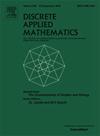On total chromatic number of complete multipartite graphs
IF 1
3区 数学
Q3 MATHEMATICS, APPLIED
引用次数: 0
Abstract
In 1995, Hoffman and Rodger conjectured that the total chromatic number of the complete -partite graph is if and only if and if has an even number of vertices then is at least the number of parts of odd size. The conjecture is known to be true when has odd number of vertices. When is even, the problem is quite difficult and is still open with little progress being made. The problem was settled for complete 3-partite graphs by Chew and Yap in 1992, and for complete 4-partite graphs by Dong and Yap in 2000; the difficulty rises manifold with the increase in the number of parts. In 2014, Dalal and Rodger (Graphs and Combinatorics (2015), 1–15) introduced an approach using amalgamations to attack the conjecture and demonstrated its power by settling the problem for complete 5-partite graphs. Their approach required coloring of all the vertices in each part with the same color. However, if the conjecture is true, then for each , there are complete -partite graphs for which any total coloring of in which all the vertices in each part are colored the same would require at least colors, although . In this paper, we provide a generalized technique that allows the vertices in the same part to have different colors by adapting a result of Bahmanian and Rodger (J. Graph Theory (2012), 297–317) on graph amalgamations. Using our technique, we solve the classification problem for all complete 6-partite graphs.
关于完全多部图的总色数
1995年,Hoffman和Rodger推测完全p部图K=K(r1,…,rp)的总色数χ”(K)当且仅当K≠Kr,r且K有偶数个顶点时,则def(K)=Σv∈V(K)(Δ(K)−dK(V))至少是奇数个大小的部分的个数。当K有奇数个顶点时,这个猜想是成立的。当K是偶数时,这个问题是相当困难的,仍然是开放的,几乎没有进展。1992年Chew和Yap解决了完全3部图的问题,2000年Dong和Yap解决了完全4部图的问题;随着零件数量的增加,难度成倍增加。2014年,Dalal和Rodger (Graphs and Combinatorics(2015), 1-15)介绍了一种使用合并来攻击猜想的方法,并通过解决完全五部图的问题证明了它的力量。他们的方法要求用相同的颜色为每个部分的所有顶点上色。然而,如果这个猜想是正确的,那么对于每一个3≤k∈N,存在完全的2k部图k,其中k的任何总着色,其中每个部分的所有顶点都是相同的,至少需要Δ(k)+2种颜色,尽管χ”(k)=Δ(k)+1。在本文中,我们通过采用Bahmanian和Rodger (J. Graph Theory(2012), 297-317)关于图合并的结果,提供了一种通用技术,允许同一部分的顶点具有不同的颜色。利用我们的技术,我们解决了所有完全六部图的分类问题。
本文章由计算机程序翻译,如有差异,请以英文原文为准。
求助全文
约1分钟内获得全文
求助全文
来源期刊

Discrete Applied Mathematics
数学-应用数学
CiteScore
2.30
自引率
9.10%
发文量
422
审稿时长
4.5 months
期刊介绍:
The aim of Discrete Applied Mathematics is to bring together research papers in different areas of algorithmic and applicable discrete mathematics as well as applications of combinatorial mathematics to informatics and various areas of science and technology. Contributions presented to the journal can be research papers, short notes, surveys, and possibly research problems. The "Communications" section will be devoted to the fastest possible publication of recent research results that are checked and recommended for publication by a member of the Editorial Board. The journal will also publish a limited number of book announcements as well as proceedings of conferences. These proceedings will be fully refereed and adhere to the normal standards of the journal.
Potential authors are advised to view the journal and the open calls-for-papers of special issues before submitting their manuscripts. Only high-quality, original work that is within the scope of the journal or the targeted special issue will be considered.
 求助内容:
求助内容: 应助结果提醒方式:
应助结果提醒方式:


